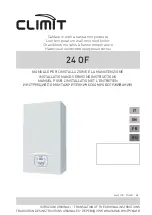
4.3
ASSEMBLY PRACTICE
Remove all plastic debris and burrs when installing air intake piping. Plastic filings caused
by cutting muPVC pipe must not be allowed to be drawn into the combustion air blower.
Prevent dust entering the air intake when cutting on building sites. Blower failure which is
determined to be caused by plastic filings or other debris will not be covered by guarantee.
4.4
INSTALLING FLUE AND AIR PIPES
IMPORTANT - When installing the boiler on an existing system a new flue and air
intake system MUST also be installed. You must NOT re-use existing flue or air
pipework components.
NB:
When installing the boiler, consider:
Flue Spigot Assembly
The flue spigot (50mm muPVC) is inside the accessory bag.
Put the flue spigot assembled with the test plug on the cabinet frame and secure
it by fastening the two M6 screws. Couple the spigot to the internal flue pipe using
the flexible couple and fastening clips. Ensure the clips are properly secured and
no leakage can occur.
Remember the flue pipe must slope downwards back towards the boiler and this
is best achieved using 92.5
o
bends.
a
Using the template supplied within the boiler packaging mark the
positions of the two holes for the flue and air pipes on the wall(s) or
ceiling.
b
Drill the two holes in the wall/ceiling, preferably using a core drill.
c
Measure, cut and check the air and flue pipes to pass to the exit from the
wall(s) or ceiling.
Always thoroughly deburr all pipes and, most important, remove shavings from
within the pipe.
d
Mount the boiler on the wall bracket and fix the air spigot (packed loose
with the boiler and with appropriate gasket) to the boiler air inlet
connection tightly to ensure there is no leakage. Assemble, using
adhesive, the pipework from the boiler connections to the exit from the
first wall/ceiling (remount the boiler if removed). When pushing pipe
through walls, ensure grit and dust is not allowed to enter the pipe.
Ensure pipes are fully engaged into sockets and solvent welded with no
leaks.
e
Using the same methods drill any further holes (always covering existing
pipework), cut and assemble the pipework.
f
From outside, complete the two terminations - See Section 3.8 Flue
System and make good all holes. (wall sealing collars are available to
make good hole areas on the wall face (part number C.08.0.00.07.0)
g
Support any pipes whose route could be displaced either of its own
accord or by accident. Any horizontal run over 1m or vertical runs of any
length must always be supported. Brackets should be placed at intervals
of approximately 1m.
h
Check all connections for security and re-seal any joints using solvent
cement where soundness may be in doubt.
Note:
It is equally important to seal the air inlet with solvent cement as the flue outlet
pipe joints.
4.5
CONDENSATE DRAINAGE
NB:
When installing the boiler, consider:
Condensate Trap Assembly
The condensate trap is fitted loose inside the cabinet.
i)
remove the nut from the condensate trap spigot;
ii)
fit the condensate trap through the two holes in the bottom of the
frame;
WD388/0/2004
Chapter 4 : Installation
The Keston C36 Combi & C36P Combi Boilers
Installation & Servicing Instructions
Page : 21
















































